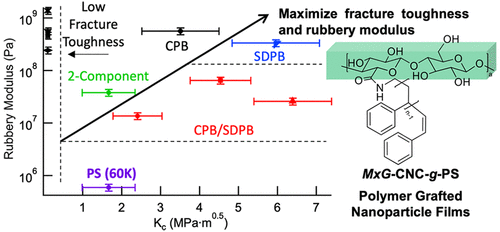当前位置:
X-MOL 学术
›
Macromolecules
›
论文详情
Our official English website, www.x-mol.net, welcomes your
feedback! (Note: you will need to create a separate account there.)
Effect of Graft Molecular Weight and Density on the Mechanical Properties of Polystyrene-Grafted Cellulose Nanocrystal Films
Macromolecules ( IF 5.1 ) Pub Date : 2021-11-14 , DOI: 10.1021/acs.macromol.1c01886
James H. Lettow 1 , Han Yang 1 , Paul F. Nealey 1 , Stuart J. Rowan 1, 2, 3
Macromolecules ( IF 5.1 ) Pub Date : 2021-11-14 , DOI: 10.1021/acs.macromol.1c01886
James H. Lettow 1 , Han Yang 1 , Paul F. Nealey 1 , Stuart J. Rowan 1, 2, 3
Affiliation

|
Polymer-grafted nanoparticle (PGN) films were prepared from polystyrene (PS) grafted to rodlike cellulose nanocrystals (MxG-CNC-g-PS) with a controllable grafting density (0.03–0.25 chains/nm2) and molecular weight (5–60 kg/mol). These nanorod-based PGNs are solution- and melt-processible, permitting access to one-component composite films with high nanofiller loadings (with up to 55 wt %). The impact of both grafted polymer density and molecular weight on the mechanical properties of the films was investigated and related to the polymer brush conformation: concentrated polymer brush (CPB), semidilute polymer brush (SDPB), or CPB core with SDPB corona (CPB/SDPB). The rubbery regime storage modulus (above Tg) showed 2 orders of magnitude increase, maximizing at a low degree of polymerization (N) and low grafting density (σ). Fracture toughness was maximized in samples with the grafted polymer in the SDPB or CPD/SDPB (higher N and relatively low σ) regime and showed enhancement relative to PS of molecular weight similar to the graft. In line with prior computation predictions, optimizing for both rubbery modulus and fracture toughness in such nanorod-based PGN films requires the polymers in the SDPB regime and CNC loading levels (ca. 50–60 wt %) that are difficult to attain in more traditional two-component CNC composites.
中文翻译:

接枝分子量和密度对聚苯乙烯接枝纤维素纳米晶薄膜力学性能的影响
聚合物接枝纳米颗粒 (PGN) 薄膜由接枝到棒状纤维素纳米晶体 ( MxG -CNC- g -PS ) 的聚苯乙烯 (PS) 制备而成,接枝密度 (0.03–0.25 链/nm 2 ) 和分子量 (5–60公斤/摩尔)。这些基于纳米棒的 PGN 可进行溶液和熔融加工,允许获得具有高纳米填料负载量(高达 55 重量%)的单组分复合薄膜。研究了接枝聚合物密度和分子量对薄膜机械性能的影响,并与聚合物刷构象有关:浓缩聚合物刷 (CPB)、半稀聚合物刷 (SDPB) 或带有 SDPB 电晕的 CPB 核 (CPB/ SDPB)。橡胶态储能模量(高于T g) 显示出 2 个数量级的增加,在低聚合度 ( N ) 和低接枝密度 (σ) 下最大化。在 SDPB 或 CPD/SDPB(较高N和相对较低 σ)方案中,接枝聚合物样品的断裂韧性最大化,并且相对于与接枝相似的分子量的 PS 显示出增强。与先前的计算预测一致,优化此类基于纳米棒的 PGN 薄膜的橡胶模量和断裂韧性需要 SDPB 体系中的聚合物和 CNC 负载水平(约 50-60 重量%),这在更传统的方法中难以实现双组分 CNC 复合材料。
更新日期:2021-11-23
中文翻译:

接枝分子量和密度对聚苯乙烯接枝纤维素纳米晶薄膜力学性能的影响
聚合物接枝纳米颗粒 (PGN) 薄膜由接枝到棒状纤维素纳米晶体 ( MxG -CNC- g -PS ) 的聚苯乙烯 (PS) 制备而成,接枝密度 (0.03–0.25 链/nm 2 ) 和分子量 (5–60公斤/摩尔)。这些基于纳米棒的 PGN 可进行溶液和熔融加工,允许获得具有高纳米填料负载量(高达 55 重量%)的单组分复合薄膜。研究了接枝聚合物密度和分子量对薄膜机械性能的影响,并与聚合物刷构象有关:浓缩聚合物刷 (CPB)、半稀聚合物刷 (SDPB) 或带有 SDPB 电晕的 CPB 核 (CPB/ SDPB)。橡胶态储能模量(高于T g) 显示出 2 个数量级的增加,在低聚合度 ( N ) 和低接枝密度 (σ) 下最大化。在 SDPB 或 CPD/SDPB(较高N和相对较低 σ)方案中,接枝聚合物样品的断裂韧性最大化,并且相对于与接枝相似的分子量的 PS 显示出增强。与先前的计算预测一致,优化此类基于纳米棒的 PGN 薄膜的橡胶模量和断裂韧性需要 SDPB 体系中的聚合物和 CNC 负载水平(约 50-60 重量%),这在更传统的方法中难以实现双组分 CNC 复合材料。

































 京公网安备 11010802027423号
京公网安备 11010802027423号